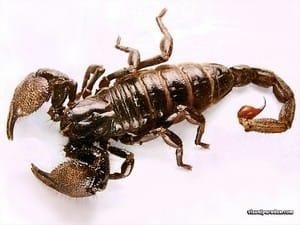Source(s): Based on information from Dr. Rodney Coleman, Former Extension Entomologist, Cooperative Extension, The University of Georgia College of Agricultural and Environmental Sciences.
Scorpions are fairly common throughout the state. While they seldom sting, their presence around the home is objectionable to many people. Scorpion stings are usually no more poisonous than those of bees or wasps.
Description
Scorpions are not insects. They are classified as arachnids and, therefore, are related to spiders and ticks. They use their large pincherlike front legs for defense, climbing, courtship and to capture prey. Their stinger is at the tip of a long, narrow tail and is used for defense and killing prey. Adult scorpions reach a length of exceeding 2 1/2 inches. Those found in Georgia are black, brown or gray in color.
Their habits
Scorpions feed on a wide variety of organisms, including insects, spiders, centipedes and millipedes, and even small reptiles. Their vision is very poor, so they often hide in ambush for their prey. They prefer a moist habitat as that is where their prey also resides. Scorpions are commonly found in rock and wood piles, stacks of rubble, in brick or rock walls, crawl spaces or in leaf litter or mulch materials.
Scorpions live from three to five years. The male and female go through a courtship similar to that of spiders, after which the female gives birth to live young. After birth, the young scorpions climb onto the back of the mother and remain fastened by their pincers until after the first molt. The young scorpions are nourished by yolk material stored in their bodies and, contrary to popular opinion, do not eat the body of the mother.
No real danger
Many fantastic superstitions have arisen concerning the scorpion. Probably no other related animal has been the subject of so many folk tales. However, scorpions are usually not aggressive and raise their pinchers and tail to merely scare away intruders.
Scorpions rarely sting man; but when they do, it’s only after provocation. Fortunately, only a few species are deadly. The venom apparently varies in its potency from season to season. Persons stung in the spring, when scorpions first emerge, have more severe reactions because of the larger amount of venon present in their bodies at this time. Also, susceptibility to scorpion poison is extremely variable, even among individuals of the same age. For most people, a scorpion sting produces a sharpe sensation like a bee-sting that lasts for 10-20 minutes. To be safe, all scorpion stings should be treated by a physician.
Control Measures
Remove old boards, cardboard, loose rocks, old mattresses and other debris from near occupied buildings, Use caulking to close small cracks where pests may enter.
For chemical control, apply a household spray labeled for crawling insects. Follow all label precautions Materials should be applied to places where scorpions are found hiding, Apply around baseboards, quarter rounds, and especially where small openings are present around water pipes and other fittings. If scorpions persist, the treatment should be repeated according to label directions.
Recommended Pesticides
carbaryl dust
cyfluthrin spray
cypermethrin spray
tralomethrin spray
Pesticide Precautions
If you use insecticides inside the home:
- Do not contaminate food, water, utensils, etc. Be sure to keep the solution away from stoves or open flames.
- Observe all restrictions and precautions on pesticide labels.
- Store all pesticide in original containers with labels intact and behind locked doors.
- Apply pesticides carefully to avoid drift.
- Bury surplus pesticides and destroy used containers so that contamination of water and other hazards will not result
Center Publication Number: 50
- Scary Scorpions - September 23, 2013
